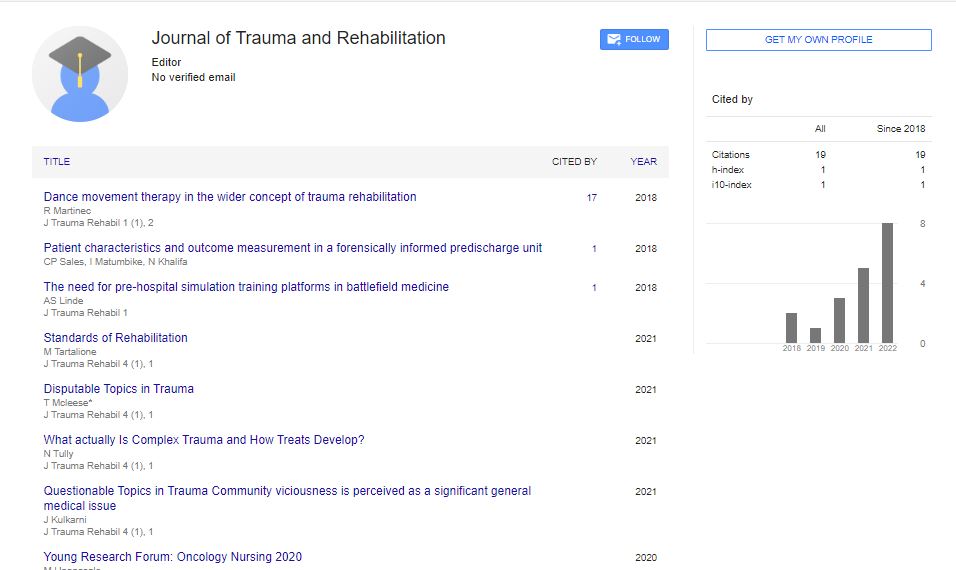Opinion Article, J Trauma Rehabil Vol: 6 Issue: 4
Managing the Convergence of Shock and Pain in Trauma Rehabilitation
Amelia Fallat*
1Department of Trauma and Critical Care, University of Arizona, Arizona, United States of America
*Corresponding Author: Amelia Fallat,
Department of Trauma and Critical Care,
University of Arizona, Arizona, United States of America
E-mail: amelfall@trauma.arizona.edu
Received date: 24 November, 2023, Manuscript No. JTR-24-127962;
Editor assigned date: 27 November, 2023, PreQC No. JTR-24-127962 (PQ);
Reviewed date: 11 December, 2023, QC No. JTR-24-127962;
Revised date: 18 December, 2023, Manuscript No. JTR-24-127962 (R);
Published date: 26 December, 2023, DOI: 10.4172/Jtr.1000146
Citation: Fallat A (2023) Managing the Convergence of Shock and Pain in Trauma Rehabilitation. J Trauma Rehabil 6:4.
Description
Trauma, both physical and psychological, can send shockwaves throughout an individual's entire body, leaving an unforgettable impression on both the mind and body. In the field of trauma rehabilitation, understanding and managing the convergence of shock and pain is paramount to fostering comprehensive recovery. The trauma rehabilitation lies in the acknowledgment that shock and pain are interwoven facets of the traumatic experience. Trauma, whether stemming from accidents, violence or other life-altering events, often induces a state of shock; a profound and disorienting reaction that reverberates through an individual's entire system. This shock is not confined to the immediate aftermath but can persist, shaping the landscape of physical and emotional pain. Physical injuries incurred during traumatic events are tangible manifestations of shock. In rehabilitation, addressing these physical repercussions requires a multifaceted approach.
Medical interventions, physical therapy and pain management strategies become integral components of the rehabilitation plan, aiming not only to alleviate pain but also to restore functionality and mobility. The convergence of shock and pain extends beyond the physical field to encompass the complex landscape of psychological trauma. The shock experienced during a traumatic event can manifest as emotional distress, ranging from acute stress reactions to more complex conditions such as Post-Traumatic Stress Disorder (PTSD). In the rehabilitation process, mental health professionals play a vital role in helping individuals navigate the emotional dimensions of trauma, addressing the psychological pain that often accompanies the shock. The process of handling the convergence of shock and pain in trauma rehabilitation requires a customized and compassionate approach. Establishing a therapeutic alliance that fosters trust and open communication is foundational. In rehabilitation settings, clinicians collaborate with individuals to unravel the layers of shock and pain, recognizing that each person's experience is unique and shaped by various factors, including the nature of the trauma and individual resilience.
Trauma-focused therapies, such as Cognitive-Behavioral Therapy (CBT) and Eye Movement Desensitization and Reprocessing (EMDR), are effective tools in addressing the psychological impact of shock and pain. CBT helps individuals reframe negative thought patterns, fostering a more adaptive mindset in response to traumatic memories. EMDR, on the other hand, focuses on processing distressing memories, facilitating the integration of traumatic experiences into a more cohesive narrative. Support networks play a pivotal role in managing the convergence of shock and pain. In rehabilitation, individuals benefit from the encouragement of family, friends and peers who understand the challenges they face. Group therapy and support networks provide a space for shared experiences, fostering a sense of community that is instrumental in the recovery expedition. Social support acts as a buffer against the isolation that often accompanies the aftermath of trauma.
Conclusion
Education and awareness initiatives within healthcare settings and the community contribute to dismantling the barriers that may hinder individuals from seeking the integrated care they require. Ultimately, managing the convergence of shock and pain in trauma rehabilitation is a nuanced process that requires sensitivity, expertise, and collaboration. It involves guiding individuals through the complex terrain of physical and psychological recovery, recognizing the interconnected nature of their experiences. By acknowledging the convergence of shock and pain and customizing rehabilitation approaches to address both aspects, healthcare professionals contribute to a more comprehensive and effective recovery expedition for those impacted by trauma.
 Spanish
Spanish  Chinese
Chinese  Russian
Russian  German
German  French
French  Japanese
Japanese  Portuguese
Portuguese  Hindi
Hindi 